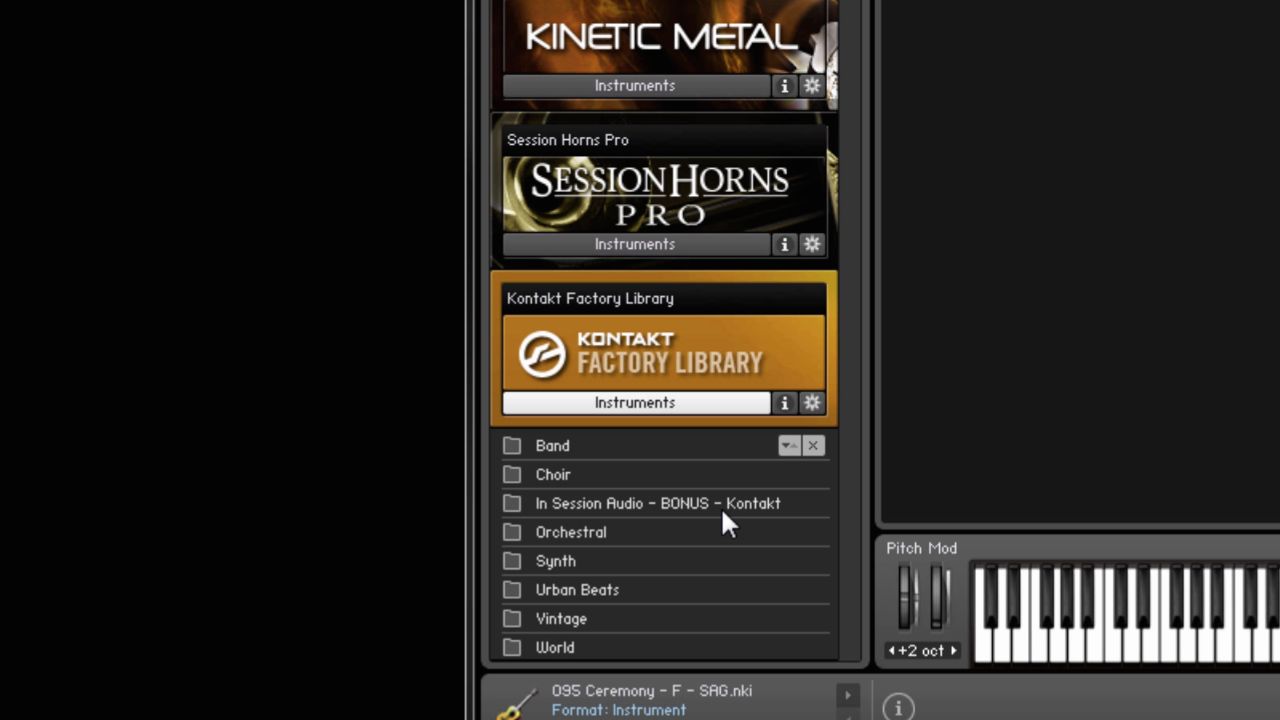

- #HOW TO ADD A KONTAKT LIBRARY SOFTWARE#
- #HOW TO ADD A KONTAKT LIBRARY PROFESSIONAL#
- #HOW TO ADD A KONTAKT LIBRARY TV#
Like most instruments in Kontakt's factory library, the Performance View of 'Subtle Bell' has two tabs: Options and Instrument. If an instrument Header doesn't contain a PV button, it means that the instrument doesn't have a Performance View.Īs you may already know, Performance Views and the parameters they display are defined within a Script. If you can't see the Instrument's Performance View, click the PV button at the far right of the Instrument Header area in the Rack. You'll notice that the 'Subtle Bell' instrument has a fairly elaborate Performance View, where you can adjust various parameters for the instrument. (Should you want to see an example of such interference, try the following tutorial with Kontakt's 'Grand Piano.nki' instrument instead.) 'Subtle Bell' allows us to add our own Script without having to worry. Although you can add scripts to any instrument you like, it's important when adding a Script to an instrument already containing a Script - as we're about to do - that the instructions in the existing Scripts don't interfere with the instructions you want to add. This might seem a curious choice of instrument, but there's a reason. Like most instruments in the Kontakt 4 Factory library, 'Subtle Bell' includes a multi‑tabbed Performance View where parameters for the instrument can be adjusted.For this example, we'll use the 'Subtle Bell.nki' instrument that's part of Kontakt 4's Factory library, from the Synth folder. Most of the discussion should also apply to Kontakt 3, but be warned that there are some subtle and some not‑so‑subtle differences between versions 3 and 4 when it comes to scripting and the built‑in Script Editor. The goal of this workshop is to get you started with those fundamentals.īefore we begin, I should mention that the following text is written with Kontakt 4, the current version, in mind. And while scripting for Kontakt can, indeed, become quite complex, even the most seemingly cryptic Script is built on simple fundamentals that are easy for anyone to learn. The whole idea of scripting is that it allows you to add functionality to Kontakt without having to know anything about the program's code. However, you don't need to be a programming wizard in order to write a Script.

While the idea of writing your own Scripts for Kontakt may seem appealing, you might be worrying about the complexity of such an endeavour. And although I wouldn't go so far as to use a cliché like "anything is possible”, KSP can certainly make a large number of your ideas for sample‑based instruments achievable. You might write instructions to add harmonies for notes that are played, control the built-in effects used in an instrument, or even create your own arpeggiators and step sequencers. It enables you to write Scripts, which can be thought of as lists of instructions that manipulate the way a Kontakt instrument works. One of Kontakt's most powerful features is the Kontakt Script Processor (KSP). It's popular with content developers and end users alike, and the number of instrument libraries available in Kontakt format seems to grow almost daily.
#HOW TO ADD A KONTAKT LIBRARY SOFTWARE#
Over the last few years, Native Instruments' Kontakt has become one of the most widely used software samplers. Take advantage of this powerful feature to customise your Kontakt patches any way you like.
#HOW TO ADD A KONTAKT LIBRARY PROFESSIONAL#
A definitive, professional level orchestral anthology, SSO gives you a realistic, cinematic blockbuster sound.The key to unlocking the power of Native Instruments' Kontakt sampler lies in its Script Processor.
#HOW TO ADD A KONTAKT LIBRARY TV#
The orchestra is made up of London’s finest session musicians, known for their work with best composers (Hans Zimmer, John Williams, Harry Gregson-Williams and more) on many blockbuster films, AAA Games and hit TV shows. Best known for its famous score recordings including the Harry Potter films, Inception, the Batman trilogy, Life of Pi, Isle of Dogs, Paddington 2, and many more. Spitfire Symphony Orchestra (SSO), presented in 3 Kontakt plugins: Strings, Brass & Woodwinds, is recorded at the home of film scoring - The Hall at AIR Studios - a rich, natural sounding hall space. Their sound offers a precise cohesion and polished performances unlike any other. Priding themselves on their live performances, these world class players are one of the most respected orchestras in the world. The BBC SO has been performing and touring the world since the 1930s. This space has a tighter, more controlled sound than many other large hall spaces, and a professional scoring stage used by the BBC for many of its famous performances, from the BBC SO to The Beatles, Hendrix and Bowie, to name a few. BBC Symphony Orchestra sample library, presented in its own dedicated plugin, has been recorded at the world famous Maida Vale Studio 1, London.


 0 kommentar(er)
0 kommentar(er)
